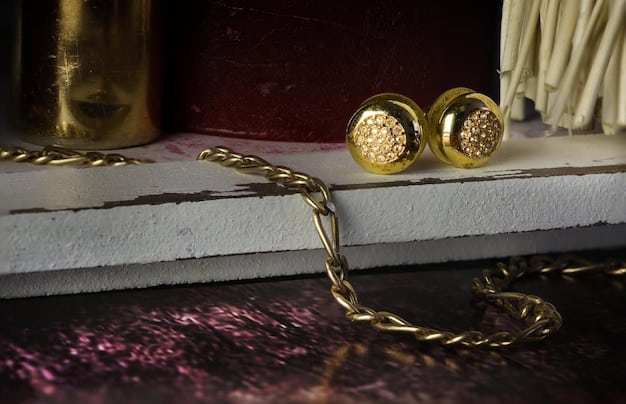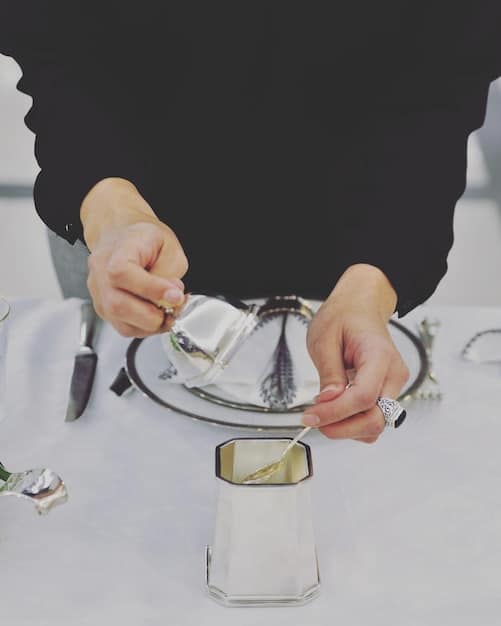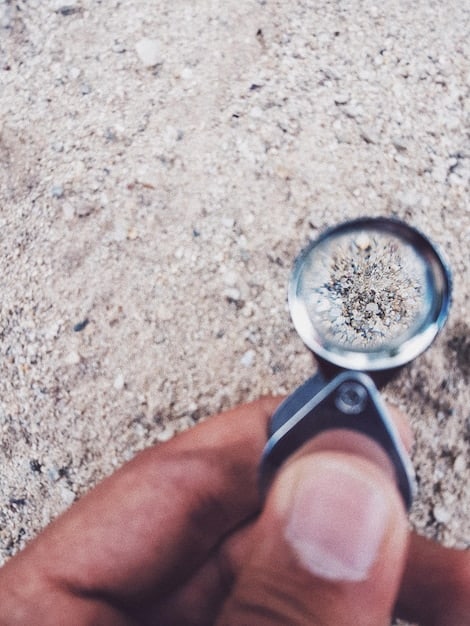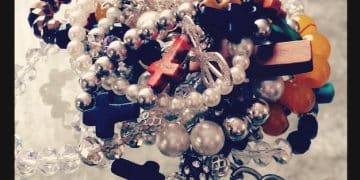Maximize Your Jewelry Collection’s Value by Year-End: 3 Key Ways

Anúncios
To maximize your jewelry collection’s value by year-end, focus on meticulous maintenance and professional cleaning, explore strategic upgrades or modifications, and consider re-evaluating for potential resale or insurance adjustments, ensuring informed decisions for enhanced longevity and worth.
As the year draws to a close, it’s an opportune moment to assess and enhance the worth of your cherished possessions. For many, a jewelry collection represents not just sentimental value but also a significant financial asset. Learning how to maximize your jewelry collection’s value by end of year is a proactive step that can yield substantial benefits, whether for future enjoyment, investment, or simply peace of mind.
Anúncios
Strategic Cleaning and Professional Maintenance
The foundation of preserving and enhancing your jewelry’s value lies in consistent care. Regular and professional maintenance not only maintains its aesthetic appeal but also prevents damage that could diminish its worth over time. This proactive approach ensures that each piece retains its original luster and structural integrity, crucial for long-term value.
The Importance of Regular Cleaning and Inspection
Just as you would care for any valuable asset, jewelry requires attention. Dust, skin oils, and everyday chemicals can accumulate, dulling brilliance and, in some cases, causing subtle damage. Regular cleaning, at home and professionally, is paramount. This goes beyond just making a piece look good; it’s about safeguarding its inherent quality.
- Home Cleaning Practices: Gentle soap and warm water are often sufficient for most non-porous gemstones and metals. Always use a soft brush and avoid harsh chemicals.
- Professional Cleaning Benefits: Jewelers have specialized equipment and solutions that can reach intricate areas and safely clean delicate pieces. They can also perform initial inspections for loose stones or worn prongs.
- Inspection for Wear and Tear: Over time, everyday wear can loosen settings or abrade metal. A professional eye can spot these issues early, preventing costly repairs or even loss of stones.
When to Seek Professional Help
While home care offers convenience, professional cleaning and maintenance by a certified jeweler are indispensable. They possess the expertise to handle delicate materials and intricate designs, ensuring that no harm comes to your precious items. A professional can also provide a detailed assessment of each piece’s condition.
Anúncios
Beyond routine cleaning, consider professional services for:
- Annual Check-ups: Just like a car or a home, your jewelry benefits from an annual check-up. This allows for thorough cleaning, inspection, and preventative maintenance, addressing minor issues before they become major problems.
- Damage Repair: If you notice a loose stone, a bent prong, or a broken clasp, do not attempt to fix it yourself. Professional jewelers have the tools and skills to repair these issues without compromising the integrity or value of the piece.
- Resizing and Remounting: If a piece no longer fits or you wish to update its setting, professional services ensure that these alterations are done correctly, maintaining the piece’s value and structural soundness.
Neglecting these aspects can lead to significant depreciation. A loose diamond, if lost due to neglect, drastically reduces the value of a piece. Regular attention ensures longevity and preserves the investment. Ensuring your jewelry is meticulously maintained and professionally cleaned is the first crucial step in maximizing its value, particularly as the year closes. This diligence pays dividends, maintaining both beauty and worth.
Strategic Upgrades and Modifications
Sometimes, maximizing value isn’t just about preserving what you have, but about intelligently evolving your collection. Strategic upgrades and modifications can breathe new life into older pieces, enhance their market appeal, and potentially increase their inherent worth. This might involve updating settings, adding complementary stones, or even redesigning a piece entirely to align with current trends or personal preferences, all while being mindful of how these changes impact overall value.
Evaluating Pieces for Upgrade Potential
Not every piece is a candidate for modification. Understanding which items stand to gain the most value from an upgrade is key. Focus on pieces with significant sentimental value or those containing valuable loose gemstones that could be re-set. An ethical jeweler can provide insight into which modifications are most beneficial.
Consider:
- Loose Gemstones: Do you have any loose diamonds or colored gemstones that could be incorporated into a new design, perhaps a custom ring or pendant?
- Outdated Settings: An older, less fashionable setting might be detracting from the true beauty and value of a significant stone. Updating it to a more contemporary or classic design can make a dramatic difference.
- Sentimental Value: Sometimes, an upgrade is less about market value and more about making a piece more wearable and cherished, thereby enhancing its personal value and ensuring it remains a central part of your collection.
Types of Modifications to Consider
The range of modifications is broad, from subtle enhancements to complete redesigns. Each type offers a different way to refresh and add value to your jewelry. These changes should always be undertaken with a professional jeweler who understands both design and the intrinsic value of materials.
- Setting Updates: Changing a solitaire’s setting from a dated yellow gold to a modern platinum, or from a simple four-prong to a more intricate halo design, can dramatically alter its appearance and perceived value.
- Adding Accent Stones: Surrounding a central gemstone with smaller diamonds or colored stones can enhance its brilliance and size perception, often increasing overall market appeal.
- Metal Refinishing/Plating: Replating white gold with rhodium or polishing other metals can restore their original luster, making the piece look new again.
- Custom Design: For truly old or unwearable pieces, a custom redesign can transform them into entirely new items, often incorporating elements from the original for continuity. This is a particularly impactful way to repurpose inherited pieces.
The Impact of Modifications on Value
While upgrades can enhance appeal, it’s crucial to consider their impact on monetary value. A custom design might elevate personal value but could be harder to appraise for resale if it’s too niche. Conversely, updating a setting to a more popular style can increase marketability. Always consult with an appraiser before making significant changes to ensure you understand the potential financial implications. The goal is to enhance, not diminish, the overall worth. Properly executed modifications maintain the integrity of the piece while making it more appealing or useful.

Understanding the balance between cost of modification and potential value increase is paramount. It’s an investment, and like any investment, it should be well-researched. Strategic upgrades and modifications can significantly contribute to maximizing your jewelry collection’s value by year-end, making your pieces more current, alluring, and potentially, more valuable.
Re-evaluation for Resale or Insurance Adjustments
The end of the year presents a timely opportunity to re-evaluate your jewelry collection, not merely for aesthetic purposes, but from a strategic financial perspective. This involves understanding the current market value of your pieces, which is essential for both potential resale and for ensuring adequate insurance coverage. As material prices and market trends fluctuate, what was once an accurate valuation may no longer hold true, making periodic appraisal a wise financial decision.
Why Regular Appraisals Are Crucial
The value of precious metals and gemstones is dynamic, influenced by global markets, economic conditions, and even currency exchange rates. An appraisal provides a professional, unbiased assessment of your jewelry’s current market value. This is not just a number; it’s a critical tool for informed decision-making regarding your assets.
- Fluctuating Market Conditions: Gold, silver, and diamond prices can shift significantly over time. An appraisal reflects these current market realities, ensuring your understanding of your collection’s true worth.
- Changes in Design Trends: While classic pieces often hold their value, fashion-forward designs may depreciate. Conversely, vintage pieces can sometimes appreciate in value if they align with current antique trends.
- Damage or Loss: In the event of theft or damage, an accurate, up-to-date appraisal is indispensable for filing an insurance claim and receiving fair compensation. Without it, you risk being underinsured and incurring significant financial loss.
It’s recommended to have your jewelry appraised every 3-5 years, or immediately after any significant market shift or major repair. Always choose a certified and independent appraiser to ensure objectivity and expertise. Their professional assessment is key to understanding the full financial scope of your collection.
Understanding Resale and Insurance Values
It’s important to distinguish between “resale value” and “insurance value.” While both are derived from an appraisal, they serve different purposes and may reflect different market conditions. Knowledge of both allows for strategic financial planning.
- Resale Value: This is the price you might realistically expect to receive if you were to sell your jewelry today. It’s often lower than the retail price due to market factors and dealer margins. Factors influencing resale value include condition, brand, originality, and current market demand for similar items.
- Insurance Value (Replacement Value): This is the cost to replace a piece of jewelry with an item of similar quality and characteristics if it were lost, stolen, or destroyed. It typically reflects the retail price in today’s market. This value is what your insurance company would use to determine your payout.
Before considering resale, research current market prices for similar items and consult with a reputable dealer or auction house. For insurance, ensure your policy reflects the current replacement value of your collection to avoid being underinsured. Regularly updating your insurance policy based on current appraisal values is a straightforward yet often overlooked step in securing your investment. This vigilance is a cornerstone of responsible asset management.
Strategic Considerations for Resale
Deciding to resell a piece of jewelry should be a considered decision. It’s not just about getting cash for unwanted items; it can be a strategic move to reallocate capital or downsize a collection. The end of the year is a unique window for this, possibly coinciding with increased consumer spending or pre-holiday sales.
- Market Timing: Certain times of the year, such as before major holidays, might see increased demand for jewelry, potentially yielding better resale prices.
- Selling Channels: Explore various options:
- Reputable Jewelry Stores: Some stores offer consignment or direct purchase.
- Auction Houses: Ideal for high-value or unique antique pieces.
- Online Platforms: Offer a wider reach but require careful vetting of buyers and secure shipping.
- Specialized Dealers: Can offer fair prices for specific types of jewelry, such as vintage or estate pieces.
- Condition and Certification: Ensure your pieces are clean, in good repair, and have any available certifications (e.g., GIA reports for diamonds), as these can significantly impact resale value.

By proactively re-evaluating your collection for both resale and insurance purposes, you empower yourself with knowledge. This allows for pragmatic decisions, whether it’s to adjust your insurance coverage, consider selling underperforming assets, or simply gaining peace of mind that your treasured items are adequately protected. Maximizing your jewelry collection’s value by year-end includes this vital financial audit.
| Key Point | Brief Description |
|---|---|
| ✨ Professional Cleaning & Maintenance | Regular professional cleaning prevents damage, preserves luster, and ensures structural integrity, maintaining long-term value. |
| 💎 Strategic Upgrades & Modifications | Updating settings, adding accent stones, or redesigning can enhance appeal and potentially increase market worth. |
| 💰 Re-evaluate for Resale & Insurance | Regular appraisals ensure adequate insurance and provide current market value for potential resale planning. |
Frequently Asked Questions About Jewelry Value
It’s generally recommended to have your jewelry appraised every 3 to 5 years. This frequency helps account for fluctuations in the market value of precious metals and gemstones, as well as changes in economic conditions and design trends. Regular appraisals ensure your insurance coverage remains adequate and reflects the current replacement cost of your pieces.
While professional cleaning doesn’t inherently increase the intrinsic value of materials, it significantly preserves and enhances a piece’s aesthetic appeal and structural integrity. By removing grime and identifying potential issues like loose prongs early, professional cleaning prevents damage that could diminish value and maintains the piece in its best possible condition for appraisal or resale.
Strategic modifications like updating outdated settings to more contemporary or classic designs, adding accent stones to enhance brilliance, or even completely redesigning a piece can significantly boost its market appeal. Furthermore, ensuring that the metal is refinished or replated can restore its original luster, making the piece look refreshed and more attractive to potential buyers.
Yes, the resale value of jewelry is typically lower than its original retail price. This difference is due to factors such as dealer markups, the condition of the piece, market demand for pre-owned items, and branding. While some rare or antique pieces might appreciate, most modern jewelry will sell for less than its initial purchase price on the secondary market.
Certifications, such as those from the Gemological Institute of America (GIA), are extremely crucial for maximizing resale value, especially for diamonds. They provide objective, third-party verification of a gemstone’s characteristics (like cut, color, clarity, and carat weight), building buyer confidence and justifying the asking price. Without such documentation, potential buyers may be hesitant or offer significantly lower amounts.
Conclusion
Maximizing your jewelry collection’s value by year-end is an achievable goal that blends diligent care with strategic financial planning. By consistently maintaining your pieces through professional cleaning and rigorous inspection, intelligently choosing upgrades and modifications that enhance both beauty and marketability, and regularly re-evaluating for accurate insurance coverage and potential resale, you can ensure your cherished assets are both beautiful and properly valued. These three key approaches, when applied thoughtfully, solidify your collection’s worth, providing confidence and security as the year concludes and new opportunities arise.





